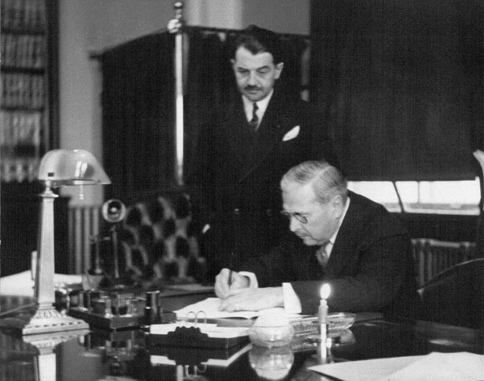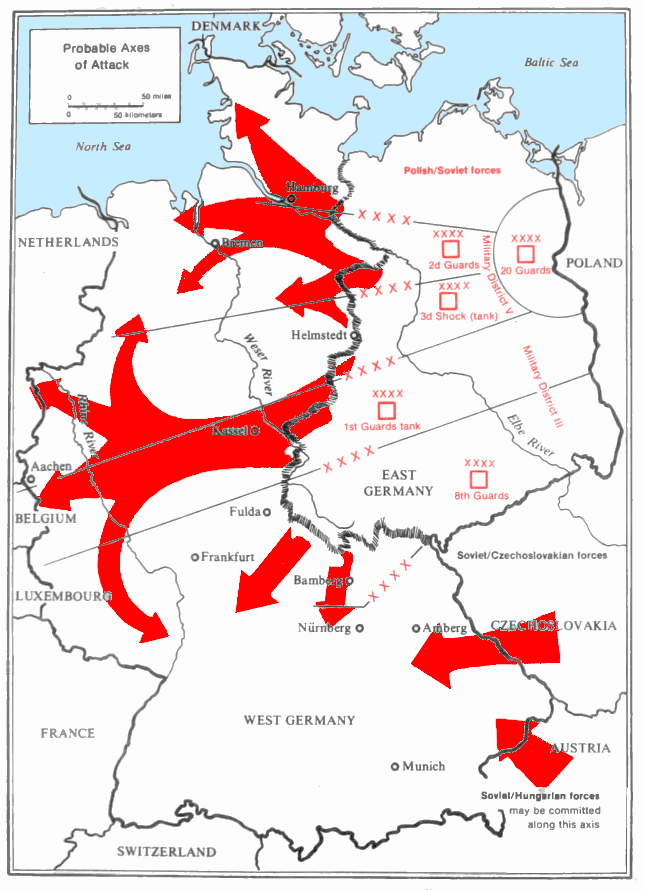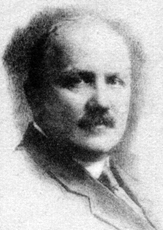|
Raymond Brugère
Charles Henri Raymond Brugère (25 January 1885 – 30 August 1966) was a French diplomat. Diplomat Brugère was born in Orléans, the son of General Joseph Brugère and Louise Thieclin. He graduated with a degree in the law. Brugère joined the Quai d'Orsay on 17 May 1911, and first went overseas to start serving as the third secretary at the French legation in Beijing on 1 August 1912. On 5 June 1912, Brugère married Denise Témoin, the daughter of a famous doctor, Daniel Témoin. By his wife, he had one child, a daughter named Nicole. As a reservist lieutenant in the ''chasseurs à cheval'', Brugère was called up to duty in August 1914 to resist the German invasion of France. He was mentioned in a report for bravery under fire on 23 September 1914. Subsequently, he transferred over to the ''Chasseurs d'Afrique'', and took part in the Dardanelles campaign of 1915. Later in 1915, Brugère went to Serbia, where he was wounded in action. Owing to his wounds, he returned to t ... [...More Info...] [...Related Items...] OR: [Wikipedia] [Google] [Baidu] |
Orléans
Orléans (;"Orleans" (US) and , ) is a city in north-central France, about 120 kilometres (74 miles) southwest of Paris. It is the prefecture of the Departments of France, department of Loiret and of the Regions of France, region of Centre-Val de Loire. Orléans is located on the river Loire nestled in the heart of the Loire Valley, classified as a Loire Valley, World Heritage Site, where the river curves south towards the Massif Central. In 2019, the city had 116,269 inhabitants within its municipal boundaries. Orléans is the center of Orléans Métropole that has a population of 288,229. The larger Functional area (France), metropolitan area has a population of 451,373, the 20th largest in France. The city owes its ... [...More Info...] [...Related Items...] OR: [Wikipedia] [Google] [Baidu] |
Canada
Canada is a country in North America. Its ten provinces and three territories extend from the Atlantic Ocean to the Pacific Ocean and northward into the Arctic Ocean, covering over , making it the world's second-largest country by total area. Its southern and western border with the United States, stretching , is the world's longest binational land border. Canada's capital is Ottawa, and its three largest metropolitan areas are Toronto, Montreal, and Vancouver. Indigenous peoples have continuously inhabited what is now Canada for thousands of years. Beginning in the 16th century, British and French expeditions explored and later settled along the Atlantic coast. As a consequence of various armed conflicts, France ceded nearly all of its colonies in North America in 1763. In 1867, with the union of three British North American colonies through Confederation, Canada was formed as a federal dominion of four provinces. This began an accretion of provinces an ... [...More Info...] [...Related Items...] OR: [Wikipedia] [Google] [Baidu] |
Siegfried Line
The Siegfried Line, known in German as the ''Westwall'', was a German defensive line built during the 1930s (started 1936) opposite the French Maginot Line. It stretched more than ; from Kleve on the border with the Netherlands, along the western border of Nazi Germany, to the town of Weil am Rhein on the border with Switzerland – and featured more than 18,000 bunkers, tunnels and tank traps. From September 1944 to March 1945 the Siegfried Line was subjected to a large-scale Allied offensive. Name The official name for the German defensive line construction program before and during the Second World War that collectively came to be known as the "Westwall" (and "Siegfried Line", or sometimes "West Wall", in English) changed several times during the late 1930s reflecting areas of progress. * Border Watch programme (pioneering programme) for the most advanced positions (1938) * Limes Programme (1938) * Western Air Defense Zone (1938) * Aachen–Saar Programme (1939) * Ge ... [...More Info...] [...Related Items...] OR: [Wikipedia] [Google] [Baidu] |
North German Plain
The North German Plain or Northern Lowland (german: Norddeutsches Tiefland) is one of the major geographical regions of Germany. It is the German part of the North European Plain. The region is bounded by the coasts of the North Sea and the Baltic Sea to the north, Germany's Central Uplands (''die Mittelgebirge'') to the south, by the Netherlands to the west and Poland to the east. In the west, the southern boundary of the North German Plain is formed by the Lower Saxon Hills: specifically the ridge of the Teutoburg Forest, the Wiehen Hills, the Weser Hills and the Lower Saxon Börde, which partly separate it from that area of the Plain known as the Westphalian Lowland. Elements of the Rhenish Massif also act a part of the southern boundary of the plain: the Eifel, Bergisches Land and the Sauerland. In the east the North German Plain spreads out beyond the Harz Mountains and Kyffhäuser further to the south as far as the Central Saxon hill country and the foothills of the Ore M ... [...More Info...] [...Related Items...] OR: [Wikipedia] [Google] [Baidu] |
Prince Paul Of Yugoslavia
Prince Paul of Yugoslavia, also known as Paul Karađorđević ( sh-Latn-Cyrl, Pavle Karađorđević, Павле Карађорђевић, English transliteration: ''Paul Karageorgevich''; 27 April 1893 – 14 September 1976), was prince regent of the Kingdom of Yugoslavia during the minority of King Peter II. Paul was a first cousin of Peter's father, Alexander I. Early life Prince Paul of Yugoslavia was the only son of Prince Arsen of Serbia, younger brother of King Peter I, and of Princess and Countess Aurora Pavlovna Demidova, a granddaughter on one side of the Finnish philanthropist Aurora Karamzin and her Russian husband Prince and Count Pavel Nikolaievich Demidov and on the other of the Russian Prince Peter Troubetzkoy and his wife, Elisabeth Esperovna, by birth a Princess Belosselsky-Belozersky. The House of Karađorđević was in exile with Serbia being ruled by their archenemies, the House of Obrenović. Paul grew up in Geneva and was raised as a lonely and abando ... [...More Info...] [...Related Items...] OR: [Wikipedia] [Google] [Baidu] |
Belgrade
Belgrade ( , ;, ; Names of European cities in different languages: B, names in other languages) is the Capital city, capital and List of cities in Serbia, largest city in Serbia. It is located at the confluence of the Sava and Danube rivers and the crossroads of the Pannonian Basin, Pannonian Plain and the Balkan Peninsula. Nearly 1,166,763 million people live within the administrative limits of the City of Belgrade. It is the third largest of all List of cities and towns on Danube river, cities on the Danube river. Belgrade is one of the List of oldest continuously inhabited cities, oldest continuously inhabited cities in Europe and the world. One of the most important prehistoric cultures of Europe, the Vinča culture, evolved within the Belgrade area in the 6th millennium BC. In antiquity, Thracians, Thraco-Dacians inhabited the region and, after 279 BC, Celts settled the city, naming it ''Singidunum, Singidūn''. It was Roman Serbia, conquered by the Romans under the reign ... [...More Info...] [...Related Items...] OR: [Wikipedia] [Google] [Baidu] |
Gerhard Weinberg
Gerhard Ludwig Weinberg (born 1 January 1928) is a German-born American diplomatic and military historian noted for his studies in the history of Nazi Germany and World War II. Weinberg is the William Rand Kenan, Jr. Professor Emeritus of History at the University of North Carolina at Chapel Hill. He has been a member of the history faculty at UNC-Chapel Hill since 1974. Previously he served on the faculties of the University of Michigan (1959–1974) and the University of Kentucky (1957–1959). Youth and education Weinberg was born in Hanover, Germany, and resided there the first ten years of his life. As Jews living in Nazi Germany, he and his family suffered increasing persecution. They emigrated in 1938, first to the United Kingdom and then in 1941 to New York State. Weinberg became a U.S. citizen, served in the U.S. Army during its Occupation of Japan in 1946-1947, and returned to receive a BA in social studies from the State University of New York at Albany. He received h ... [...More Info...] [...Related Items...] OR: [Wikipedia] [Google] [Baidu] |
Benito Mussolini
Benito Amilcare Andrea Mussolini (; 29 July 188328 April 1945) was an Italian politician and journalist who founded and led the National Fascist Party. He was Prime Minister of Italy from the March on Rome in 1922 until his deposition in 1943, and "Duce" of Italian Fascism from the establishment of the Italian Fasces of Combat in 1919 until his execution in 1945 by Italian partisans. As dictator of Italy and principal founder of fascism, Mussolini inspired and supported the international spread of fascist movements during the inter-war period. Mussolini was originally a socialist politician and a journalist at the ''Avanti!'' newspaper. In 1912, he became a member of the National Directorate of the Italian Socialist Party (PSI), but he was expelled from the PSI for advocating military intervention in World War I, in opposition to the party's stance on neutrality. In 1914, Mussolini founded a new journal, ''Il Popolo d'Italia'', and served in the Royal Italian Army durin ... [...More Info...] [...Related Items...] OR: [Wikipedia] [Google] [Baidu] |
Lionel Groulx
Lionel Groulx (; 13 January 1878 – 23 May 1967) was a Canadian Roman Catholic priest, historian, and Quebec nationalism, Quebec nationalist. Biography Early life and ordination Lionel Groulx, né Joseph Adolphe Lyonel Groulx, the son of a farmer and lumberjack, and direct descendant of New France pioneer Coulée Grou, Jean Grou, was born and died at Vaudreuil-Dorion, Quebec, Vaudreuil, Quebec. After his seminary training and studies in Europe, he taught at Collège de Valleyfield, Valleyfield College in Salaberry-de-Valleyfield, Quebec, Salaberry-de-Valleyfield, and then the Université de Montréal. In 1917 he co-founded a monthly journal called ''L'Action nationale, Action Française'', becoming its editor in 1920. Study of Confederation Groulx was one of the first Quebec historians to study Confederation: he insisted on its recognition of Quebec rights and minority rights, although he believed a combination of corrupt political parties and French Canadian minority stat ... [...More Info...] [...Related Items...] OR: [Wikipedia] [Google] [Baidu] |
Exposition Internationale Des Arts Et Techniques Dans La Vie Moderne
The ''Exposition Internationale des Arts et Techniques dans la Vie Moderne'' (International Exposition of Art and Technology in Modern Life) was held from 25 May to 25 November 1937 in Paris, France. Both the Palais de Chaillot, housing the Musée de l'Homme, and the Palais de Tokyo, which houses the Musée d'Art Moderne de la Ville de Paris, were created for this exhibition that was officially sanctioned by the Bureau International des Expositions. A third building, , housing the permanent Museum of Public Works, which was originally to be among the new museums created on the hill of Chaillot on the occasion of the Exhibition, was not built until January 1937 and inaugurated in March 1939. Exhibitions At first the centerpiece of the exposition was to be a tower (" Phare du Monde") which was to have a spiraling road to a parking garage located at the top and a hotel and restaurant located above that. The idea was abandoned as it was far too expensive. Pavilions Finnish P ... [...More Info...] [...Related Items...] OR: [Wikipedia] [Google] [Baidu] |
Ernest Lapointe
Ernest Lapointe (October 6, 1876 – November 26, 1941) was a Canadian lawyer and politician. A member of Parliament from Quebec City, he was a senior minister in the government of Prime Minister W. L. Mackenzie King, playing an important role on issues relating to legal affairs, Quebec and French-speaking Canada. Education, early career Lapointe earned his law degree from Laval University. He was called to the bar in 1898 and practised law in Rivière-du-Loup and Quebec City. Enters politics Lapointe was elected by acclamation to the House of Commons of Canada for the riding of Kamouraska as a Liberal through a by-election on February 12, 1904. Lapointe was later re-elected in the 1904, 1908, 1911, and 1917 federal elections. Lapointe resigned his seat in 1919 and successfully ran in the Quebec East seat vacated by former Prime Minister Wilfrid Laurier, who died. King's cabinet minister and Quebec lieutenant In 1921, Prime Minister William Lyon Mackenzie King a ... [...More Info...] [...Related Items...] OR: [Wikipedia] [Google] [Baidu] |

.jpg)


.jpg)


